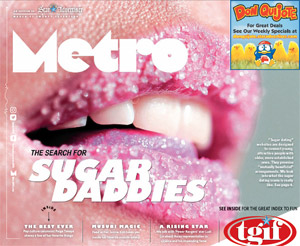THE FUTURE IS NOW
By James Charisma
This coming Wednesday, Oct. 21, Marty McFly and Dr. Emmett “Doc” Brown will travel from 1985 to 2015. For them, it’ll seem like an instant. For fans of the Back To The Future film trilogy, it’s been 30 years coming.
When Back To The Future was first pitched to Columbia Pictures in 1980, the studio wasn’t thrilled. This was the era when popular teen comedies included Porky’s and Revenge of the Nerds. Instead, filmmakers Robert Zemeckis and Bob Gale delivered a complicated and bizarre sci-fi epic, featuring an elderly scientist, alternate timelines and a mother falling in love with her son. It was only with encouragement from Steven Spielberg that Universal Pictures eventually picked it up.
Upon its release, Back To The Future received critical acclaim and was a surprise box office hit, becoming the highest-grossing film of 1985. A sequel was planned; this time, for the characters to travel into the future. However, it was never intended to be an actual depiction of 2015.
According to director Robert Zemeckis, “Rather than trying to make a scientifically sound prediction that we were probably going to get wrong anyway, we figured, let’s just make it funny.”
Zemeckis and Gale had fun with flying cars and hover-boards and holograms in Back To The Future Part II, but now that audiences finally have caught up with Marty and the Doc, we’re surprised to see that the filmmakers aren’t too far off the mark. When Marty stumbles through Hill Valley in 2015, he’s surrounded by electronic billboards, bionic implants, newly designed Pepsi logo and bottles, the mention of a female president in the newspaper, and an augmented reality advertisement for Jaws 19.
Later, when Marty sneaks into his own future house, his family’s wearing Google Glass-type visors, flipping past channels depicting scenes of scenery on their state-of-the-art wall-mounted TV. The film predicts videoconferencing and cameras with facial recognition ability. And outside? Curbside recycling. Down the street, a drone walks a dog.
Our cars may not fly, but many of the ones in the film do resemble flatter Toyota Priuses, PT Cruisers, or the other electric shavers on the road today. And don’t forget that Doc’s upgraded time-travel DeLorean is a hybrid.
But there’s a lot of technology, like self-zipping clothes or the abundance of fax machines, that are way off the mark. And from the peanut gallery (especially come Wednesday), there will be those who invariably ask, “Where are our hover-boards?” Those are the fans who will have missed the point.
Because at its core, Back To The Future isn’t telling us what will be. It’s asking us what could be. “If you put your mind to it, you can accomplish anything,” is repeated frequently between characters in the first film. Endless possibilities; nothing is set in stone. Whether we’re in 1955 or 1985 or 2015, the future is up to us. Next stop, 2045. We’ll get there.
James Charisma is the director of Charisma Industries, a creative design agency in Honolulu.
“A SHARED SPACE” is an ongoing reader-submitted column. To share your story, email coconnor@midweek.com

